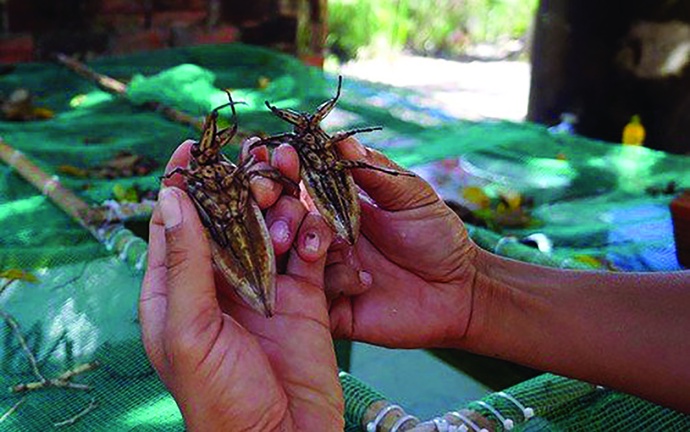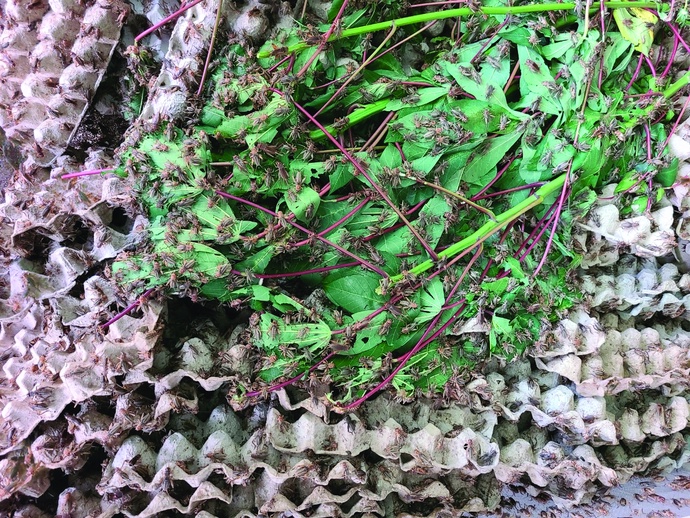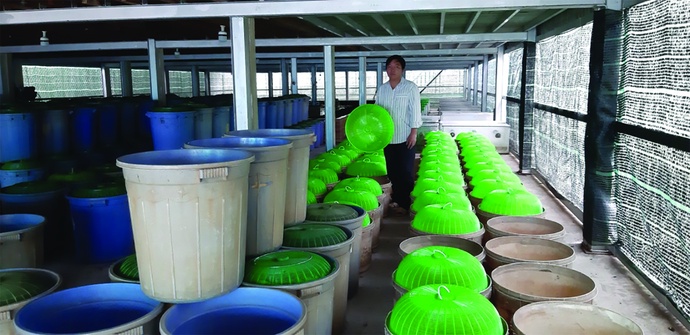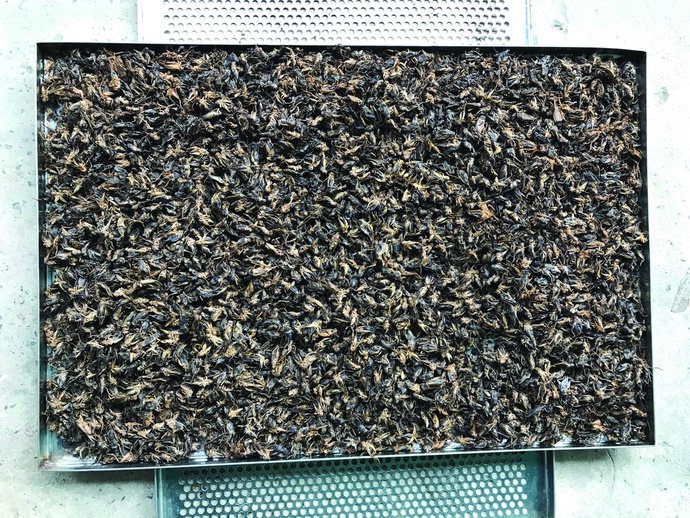After making their way on to the menus of upscale restaurants throughout Vietnam, do farmed bugs have a shot at becoming a staple on grocery store shelves?
Inside his half-a-hectare farmstead in the Mekong Delta’s Long An Province, 51-year-old Truong Thanh Dung is working on an unorthodox model of husbandry: raising crickets in shallow holes the size of a coffee table.
Dung began cricket farming about two decades ago when the trade was still new to Long An.
Now, with nearly 20 years of practice under his belt, he proudly runs one of the most successful cricket farms in the province.
Using discarded paper egg trays, he divides each of the shallow cricket holes into layers, allowing the insects to thrive.
The crickets are a breeze to take care of – they rarely get sick and enjoy eating a wide range of foods, according to Dung.
Crickets are also considered a 'clean' source of food as the insects will die if they eat any chemical.
The key to success in cricket farming, Dung said, lies in the devotion of the farmer, a trait critical to ensuring the size and potential of each cricket.
“A veteran farmer is able to understand each of his crickets," Dung said.
"They know when to increase the density of the swarm inside the coops in order to provide more heat during cold weather, or if the crickets need to be spaced out in order to cope with the heat.
“Crickets that are well farmed are quite eye-catching and tend to sell better."
Dung’s cricket harvests are used as food for both livestock and humans.
Crickets for restaurants will be subject to strict requirements.
Typically, they are kept in less crowded environments and raised for 40 days.
Those used as animal feed are kept in more crowded environments and only raised for 20-30 days.
|
|
| Truong Thanh Dung’s facility in Long An Province, Vietnam uses discarded egg cartons to provide shelter for farmed crickets. Photo: Minh Dung / Tuoi Tre |
Dung’s fellow cricket farmer, Le Thanh Tung, 40, from Ho Chi Minh City, has about 20 years of experience in the business.
According to Tung, the taste of each cricket is dictated by the food it eats.
More specifically, crickets that munch on grass instead of soybean pulp and cassava leaves tend to taste better and seem to be more suited for the human palate.
Cricket farmers in Vietnam raise many kinds of cricket, but the most efficient for farming tend to be Thai crickets because of how quickly they grow, said Ly Thi Tu Trinh, a cricket farmer in Can Tho City.
Thai crickets can be harvested in one and a half months and sold at VND100,000 (US$4.4) per kilogram, while their eggs, which are used by farmers to start new crops, can fetch double the price. Each farming pit can yield up to VND600,000 ($26.4) in profit.
Female crickets can lay eggs up to five times before they die.
|
|
| Ho Chi Minh City-based farmer Le Thanh Tung grows crickets in plastic buckets. Photo: Trong Nhan / Tuoi Tre |
High-end food
In 2016, Cao Nguyen Do Lang, the owner of a small cricket farm in the Mekong Delta’s An Giang Province, began working on a project to farm ca cuong, a water bug used in Vietnamese cuisine for its aromatic quality.
Lang's first batch of 100 insects turned out to be a failure, but it taught many valuable lessons.
Now, using his failure as a learning opportunity, he has created reservoirs for ca cuong using tap water and raised about 60 ca cuong individuals in each of his cages.
The insects feed on small fish, tadpoles, and crickets. Female ca cuong lay eggs every 80-95 days and their babies are ready for sale after about 45 days.
A market-ready ca cuong typically sells for VND40,000 (1.8) and a pair of breeding sell for VND400,000 ($18).
With ten dedicated cages on his farm and up to 300 ca cuong individuals sold each month, Lang turns a lucrative profit with his niche business.
|
|
| Harvested insects in a farmstead in Vietnam. Photo: Supplied |
Also in on the ca cuong trend is Le Thanh Tung, who decided to expand his insect offerings about ten years ago, using just five individuals as breeding stock.
Tung’s ca cuong swarm now boasts about 5,000 individuals which are housed in cement tanks with aquatic plants inside.
Each tank holds just 120 individuals. Any more and the bugs begin to feed on each other.
The ca cuong prefer to eat live food, which has forced Tung to build a small pond to raise his own fish for feed.
Despite offering little nutritional value, ca cuong is highly sought after for its aroma oil, which is used as an ingredient in many local dishes.
According to Tung, high-end restaurants source his ca cuong at the price of VND3.2-3.5 million ($140-154) per kilogram.
In addition to ca cuong and crickets, Tung farms scorpions which he houses in a semi-natural habitat covered with nets and filled with coconut shells to maintain moisture and provide shelter.
Because the scorpions do not cannibalize each other, he is able to keep several generations in one cage.
Tung’s scorpions can be sold after about 2.5 months at VND750,000-1 million ($33-44).
To harvest, farmers only need to flip the coconut shells and pick out the individuals. Those that are too young or too old are kept to breed future generations.
“Scorpions can live on discarded food that ca cuong leave behind, which creates a circular loop for food on my farm,” Tung said.
|
|
| Crispy fried crickets. Photo: Chi Cong / Tuoi Tre |
Bug snacks
Back in 2016, a Vietnamese company made a splash in the domestic market with a never-before-seen product: bags of seasoned, dried crickets as snacks.
The idea received a warm reception from customers for its novelty and flavor variety and showed up on the shelves of supermarkets and convenience stores throughout Vietnam.
However, the hype was quick to die down and the product was eventually pulled from shelves.
“It takes time for customers to familiarize themselves with new products,” said an executive of the bug snack manufacturer.
“The public is more used to potato chips than traditional snacks. That makes it hard for a product made from crickets to enter the market.
“The COVID-19 pandemic put multiple constraints on our company, including our cash flow, marketing, and supply chain.
"Ultimately, that ended our production.”
The weirdness of the product also presented the company with several bureaucratic obstacles.
Foodstuffs must pass multiple quality and safety checks before they can show up on the shelves of big distributors, but the current Vietnamese regulations have yet to provide guidelines on using bugs as food.
“When we sought to export the bug snacks, people were confused about whether they should be classified as human food or animal feed,” the company executive said.
According to the executive, a more viable way to introduce bugs into the food market is to grind dried insects to powder to make familiar products.
He alluded to the introduction of sushi or sashimi to markets outside of Japan, which took decades.
“I think it will take 20 to 30 years before insect-based food is accepted by the public," he remarked.
“Of course such a process would require significant financial backing.”
Like us on Facebook or follow us on Twitter to get the latest news about Vietnam!































